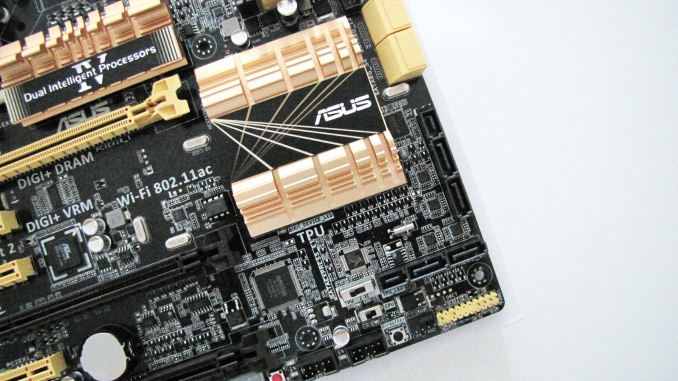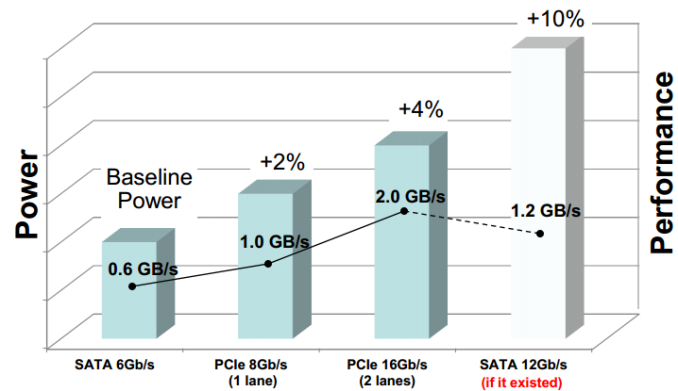Testing SATA Express And Why We Need Faster SSDs
by Kristian Vättö on March 13, 2014 7:00 AM EST- Posted in
- Storage
- SSDs
- Asus
- SATA
- SATA Express

During the hard drive era, the Serial ATA International Organization (SATA-IO) had no problems keeping up with the bandwidth requirements. The performance increases that new hard drives provided were always quite moderate because ultimately the speed of the hard drive was limited by its platter density and spindle speed. Given that increasing the spindle speed wasn't really a viable option for mainstream drives due to power and noise issues, increasing the platter density was left as the only source of performance improvement. Increasing density is always a tough job and it's rare that we see any sudden breakthroughs, which is why density increases have only given us small speed bumps every once in a while. Even most of today's hard drives can't fully saturate the SATA 1.5Gbps link, so it's obvious that the SATA-IO didn't have much to worry about. However, that all changed when SSDs stepped into the game.
SSDs no longer relied on rotational media for storage but used NAND, a form of non-volatile storage, instead. With NAND the performance was no longer dictated by the laws of rotational physics because we were dealing with all solid-state storage, which introduced dramatically lower latencies and opened the door for much higher throughputs, putting pressure on SATA-IO to increase the interface bandwidth. To illustrate how fast NAND really is, let's do a little calculation.
It takes 115 microseconds to read 16KB (one page) from IMFT's 20nm 128Gbit NAND. That works out to be roughly 140MB/s of throughput per die. In a 256GB SSD you would have sixteen of these, which works out to over 2.2GB/s. That's about four times the maximum bandwidth of SATA 6Gbps. This is all theoretical of course—it's one thing to dump data into a register but transferring it over an interface requires more work. However, the NAND interfaces have also caught up in the last couple of years and we are now looking at up to 400MB/s per channel (both ONFI 3.x and Toggle-Mode 2.0). With most client platforms being 8-channel designs, the potential NAND-to-controller bandwidth is up to 3.2GB/s, meaning it's no longer a bottleneck.
Given the speed of NAND, it's not a surprise that the SATA interface quickly became a bottleneck. When Intel finally integrated SATA 6Gbps into its chipsets in early 2011, SandForce immediately came out with its SF-2000 series controllers and said, "Hey, we are already maxing out SATA 6Gbps; give us something faster!" The SATA-IO went back to the drawing board and realized that upping the SATA interface to 12Gbps would require several years of development and the cost of such rapid development would end up being very high. Another major issue was power; increasing the SATA protocol to 12Gbps would have meant a noticeable increase in power consumption, which is never good.
Therefore the SATA-IO had to look elsewhere in order to provide a fast yet cost efficient standard in a timely matter. Due to these restrictions, it was best to look at already existing interfaces, more specifically PCI Express, to speed up the time to the market as well as cut costs.
| Serial ATA | PCI Express | |||
| 2.0 | 3.0 | 2.0 | 3.0 | |
| Link Speed | 3Gbps | 6Gbps |
8Gbps (x2) 16Gbps (x4) |
16Gbps (x2) 32Gbps (x4) |
| Effective Data Rate | ~275MBps | ~560MBps |
~780MBps ~1560MBps |
~1560MBps ~3120MBps (?) |
PCI Express makes a ton of sense. It's already integrated into all major platforms and thanks to scalability it offers the room for future bandwidth increases when needed. In fact, PCIe is already widely used in the high-end enterprise SSD market because the SATA/SAS interface was never enough to satisfy the enterprise performance needs in the first place.
Even a PCIe 2.0 x2 link offers about a 40% increase in maximum throughput over SATA 6Gbps. Like most interfaces, PCIe 2.0 isn't 100% efficient and based on our internal tests the bandwidth efficiency is around 78-79%, so in the real world you should expect to get ~780MB/s out of a PCIe 2.0 x2 link, but remember that SATA 6Gbps isn't 100% either (around 515MB/s is the typical maximum we see). The currently available PCIe SSD controller designs are all 2.0 based but we should start to see some PCIe 3.0 drives next year. We don't have efficiency numbers for 3.0 yet but I would expect to see nearly twice the bandwidth of 2.0, making +1GB/s a norm.
But what exactly is SATA Express? Hop on to next page to read more!











131 Comments
View All Comments
Khenglish - Thursday, March 13, 2014 - link
That 2.8 uS you found is driver interface overhead from an interface that doesn't even exist yet. You need to add this to the access latency of the drive itself to get the real latency.Real world SSD read latency for tiny 4K data blocks is roughly 900us on the fastest drives.
It would take an 18000 meter cable to add even 10% to that.
willis936 - Thursday, March 13, 2014 - link
Show me a consumer phy that can transmit 8Gbps over 100m on cheap copper and I'll eat my hat.Khenglish - Thursday, March 13, 2014 - link
The problem is long cables is attenuation, not latency. Cables can only be around 50M long before you need a repeater.mutercim - Friday, March 14, 2014 - link
Electrons have mass, they can't ever travel at the speed of light, no matter the medium. The signal itself would move at the speed of light (in vacuum), but that's a different thing./pedantry
Visual - Friday, March 14, 2014 - link
It's a common misconception, but electrons don't actually need to travel the length of the cable for a signal to travel through it.In layman's terms, you don't need to send an electron all the way to the other end of the cable, you just need to make the electrons that are already there react in a certain way as to register a required voltage or current.
So a signal is a change in voltage, or a change in the electromagnetic fields, and that travels at the speed of light (no, not in vacuum, in that medium).
AnnihilatorX - Friday, March 14, 2014 - link
Just to clarify, it is like pushing a tube full of tennis balls from one end. Assuming the tennis balls are all rigid so deformation is negligible, the 'cause and effect' making the tennis ball on the other end move will travel at speed of light.R3MF - Thursday, March 13, 2014 - link
having 24x PCIe 3.0 lanes on AMD's Kaveri looks pretty far-sighted right now.jimjamjamie - Thursday, March 13, 2014 - link
if they got their finger out with a good x86 core the APUs would be such an easy sellMrSpadge - Thursday, March 13, 2014 - link
Re: "Why Do We Need Faster SSDs"You power consumption argument ignores one fact: if you use the same controller, NAND and firmware it costs you x Wh to perform a read or write operation. If you simply increase the interface speed and hence perform more of these operations per time, you also increase the energy required per time, i.e. power consumption. I your example the faster SSD wouldn't continue to draw 3 W with the faster interface: assuming a 30% throughput increase expecting a power draw of 4 W would be reasonable.
Obviously there are also system components actively waiting for that data. So if the data arrives faster (due to lower latency & higher throughput) they can finish the task quicker and race to sleep. This counterbalances some of the actual NAND power draw increases, but won't negate it completely.
Kristian Vättö - Thursday, March 13, 2014 - link
"If you simply increase the interface speed and hence perform more of these operations per time, you also increase the energy required per time, i.e. power consumption."The number of IO operations is a constant here. A faster SSD does not mean that the overall number of operations will increase because ultimately that's up to the workload. Assuming that is the same in both cases, the faster SSD will complete the IO operations faster and will hence spend more time idling, resulting in less power drawn in total.
Furthermore, a faster SSD does not necessarily mean higher power draw. As the graph on page one shows, PCIe 2.0 increases baseline power consumption by only 2% compared to SATA 6Gbps. Given that SATA 6Gbps is a bottleneck in current SSDs, more processing power (and hence more power) is not required to make a faster SSD. You are right that it may result in higher NAND power draw, though, because the controller will be able to take better advantage of parallelism (more NAND in use = more power consumed).
I understand the example is not perfect as in real world the number of variables is through the roof. However, the idea was to debunk the claim that PCIe SSDs are just a marketing trick -- they are that too but ultimately there are gains that will reach the average user as well.